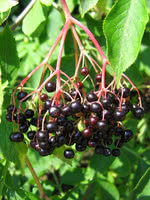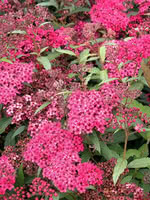Mon-Fri 9am - 5pm Mountain time
Black Elderberry vs Neon Flash Spiraea
Sambucus canadensis
Spiraea japonica Neon Flash
NOT AVAILABLE THIS SEASON - MIGHT RETURN
NOT AVAILABLE THIS SEASON - MIGHT RETURN
Black Elderberry is a deciduous shrub native to eastern North America. You can plant this shrub in moist areas and it will help stabilize your soil. You can also use it on rural properties anywhere you'd use a lilac.
Black Elderberries are considered to be partially self-pollinating. So while they will still produce some berries without cross-pollination, planting with another variety will increase yields. Consider planting with Ranch Elderberry or Bob Gordon Elderberry.
Warning: the seeds, stems, leaves, roots, and uncooked berries of the Black Elderberry are poisonous to humans when eaten in quantity. You should cook the berries to make them safe for human consumption.
Neon Flash Spiraea is a colorful, low maintenance, and multi-purpose shrub.
Late spring to fall you'll be drawn to its vibrant neon red blooms that rest on a neat mound of green foliage. If deer and rabbit are an issue on your property, consider planting Neon Flash Spiraea for its deer/rabbit resistance. Its tolerance of a variety of well-drained soils makes it an ideal foundation, landscaping, or border plant.
Black Elderberry Quick Facts
Neon Flash Spiraea Quick Facts
Toxicity: leaves, stems, and uncooked berries are poisonous to humans

